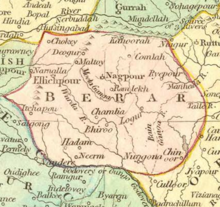Berar Subah
| Berar Subah | |||||||||
|---|---|---|---|---|---|---|---|---|---|
| ProvinceofMughals | |||||||||
| 1596–1724 | |||||||||
 Berar Subah depicted in map of Mughal Empire by Robert Wilkinson (1805) | |||||||||
| Capital | Ellichpur | ||||||||
| Area | |||||||||
• | 29,340 km2(11,330 sq mi) | ||||||||
| History | |||||||||
• Conquered byAkbar | 1596 | ||||||||
| 1724 | |||||||||
| |||||||||
| This article incorporates text from a publication now in thepublic domain:Chisholm, Hugh,ed. (1911). "Berar".Encyclopædia Britannica(11th ed.). Cambridge University Press. | |||||||||
TheBerar Subahwas one of theSubahs(provinces) of theMughal Empire,in Central India from 1596 to 1724. It borderedGolconda,Ahmandagar(both conquered in 1601),KandeshandMalwaprovinces as well as the independent and tributary kingdoms to the east.
Origin of name
[edit]According to theAin-i-Akbari,the original name of Berar wasWaradatat(the banks of Varada River).[1]
History
[edit]Before the Mughal occupation, Berar was part of the Nizam Shahi sultanate ofAhmadnagar.It was ceded to the emperorAkbarbyChand Bibiin 1596, unable to stand against the imperial forces led by princeMurad.After this initial victory Prince Murad settled in Berar with Balapur as his headquarters. Near Balapur he founded a new city namedShahpurand constructed a beautiful palace for himself. As his relationship was deteriorating withAbdul Rahim Khan-i-Khanan,the commander of the army, Akbar recalled Khan-i-Khanan and sent his trusted friendAbul Fazlto help him. Murad died in 1598. After his death, Prince Daniel was given the charge as governor of Berar, Ahmadnagar and Khandesh, Khan-i- Khanan was sent along with Daniel. Akbar died in 1605.[2]
In 1611, the southern provinces of Ahmadnagar, Berar and Khandesh defied Mughal sovereignty underMalik Ambar.Jahangir sentMan Singhand others to crush the revolt. Man Singh died a natural death on 6 July 1614 at Ellichpur. DuringJahangir’s rule,Malik Ambartill his death in 1626 recovered a substantial part of the Deccan from the Mughals including Berar. In 1628, the first year of reign ofShah Jahan,Berar again came under the Mughal sway.
In 1636, the Mughal possessions inDakhin(Deccan) were divided into 4 Subahs. Berar was one of them withEllichpuras its capital and Gavilgad as its main fort.Aurangzebwas appointed viceroy of four Deccan Subahs for the first time and he occupied the post for eight years (till 1644). He was again appointed viceroy for the second time in 1653 and he remained in that post till 1657.[3]During Aurangzeb's reign, Berar was successively overrun by the Maratha rulersShambhajiin 1680 andRajaramin 1698. In 1720, Maratha PeshwaBalaji Vishwanathobtained the grant of the right to collectchauthandsardeshmukhifrom Berar from the Mughal emperor.
In 1724, when Nizam-ul-Mulk Asaf Jah declared independence, the existence of Berar as a Mughal Subah came to an end. It became (though nominally) a part of Nizam's state.[4]
Administrative divisions
[edit]Berar came under Mughal administration in 1596.Todar Mal's famous system known asbandobastwas made applicable to the Berar Subah.
The area of the Berar Subah during Akbar's reign was 72,000 sq. miles. According toAin-i-Akbari,its northern limit was Handia, the eastern limit was the fort of Vairagad nearBastar,the southern limit was Telangana and the western limit was Mahkarabad.Ellichpurwas the capital of the Subah. The important forts of the Subah wereGawilgad,Narnala,Pavanar, Khedala, Manikdurg and Mahur. It was divided into 13sarkarsconsisting of 242parganas.[5]
The sarkars and parganas of the Berar Subah (province) were:[6]
| Sarkar (district) | No. of Parganas (tehsil) |
|---|---|
| Gavil | 46;Ellichpurwas the capital of Berar |
| Khedala | 35 |
| Pavanar | 5 |
| Narnala | 34 |
| Kalamb | 31 |
| Washim | 8 |
| Mahur | 20 |
| Manikdurg | 8 |
| Pathri | 18 |
| Telangana | 19 |
| Ramgad | 5 |
| Mehkar | 4 |
| Baitulawadi | 9 |
Economy
[edit]Thejama(revenue assessed) from Berar in 1596 was 64,26,03,270dams(Delhi).[7]Land revenue formed the major part of the total income from the Subah. Other sources of income werezakat,customs, salt tax,khums,mint, currency,jizya,escheats,presents,octroi,tolls and tributes. The coins current were tanka-i-Barari, dam and Rupee. One tanka-i-Barari was equal to 16 Delhi dams[8](but later raised to 24 dams) or eight Delhi tankas.
See also
[edit]- Berar Sultanate(pre-Mughal)
- Berar Province(after, British colonial)
Notes
[edit]- ^Abul Fazl-i-Allami (1949, reprint 1993).Ain-i-AkbariVol. II (tr. H.S. Jarrett, rev. J.N. Sarkar), Calcutta: The Asiatic Society, p.236
- ^"Wardha district e-gazetteer – administrative history".
- ^Mahajan V.D. (1991, reprint 2007).History of Medieval India,Part II, New Delhi: S. Chand,ISBN81-219-0364-5,p.143
- ^Imperial Gazetteer of India, v. 7, p. 369
- ^Abul Fazl-i-Allami (1949, reprint 1993).Ain-i-AkbariVol. II (tr. H.S. Jarrett, rev. J.N. Sarkar), Calcutta: The Asiatic Society, pp.236-9
- ^Abul Fazl-i-Allami (1949, reprint 1993).Ain-i-AkbariVol. II (tr. H.S. Jarrett, rev. J.N. Sarkar), Calcutta: The Asiatic Society, pp.240-4
- ^Habib, IrfanThe Agrarain System of Mughal India 1556-1707,Oxford University Press, New Delhi, 1999ISBN0-19-565595-8,p.462
- ^Abul Fazl-i-Allami (1949, reprint 1993).Ain-i-AkbariVol. II (tr. H.S. Jarrett, rev. J.N. Sarkar), Calcutta: The Asiatic Society, p.239n
References
[edit]- Abul Fazl-i-Allami (1949, reprint 1993).Ain-i-AkbariVol. II (tr. H.S. Jarrett, rev. J.N. Sarkar), Calcutta: The Asiatic Society.
